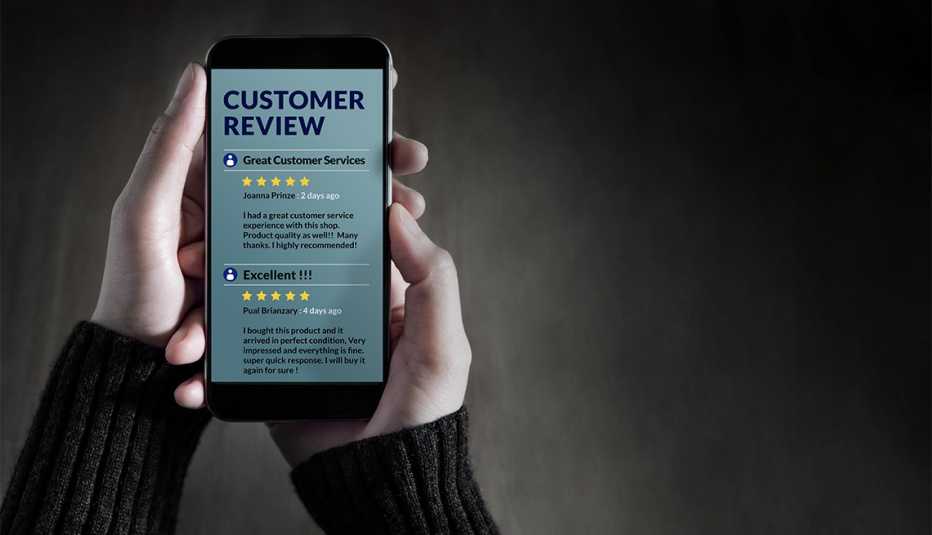Imagine you’ve found the perfect product online. The price is right, the description is spot-on, and the reviews?
Glowing. But wait—are those reviews too good to be true? In a world where fake reviews can mislead you into poor purchases, knowing how to spot them is crucial. You deserve to spend your hard-earned money wisely, and this guide will empower you to do just that.
We’ll uncover the telltale signs of fake reviews and arm you with the knowledge to make confident buying decisions. Don’t let deceptive reviews sway your choices; discover the strategies to see through the façade and ensure your purchases meet your expectations. Ready to become a savvy shopper? Let’s dive in.

Credit: www.dallasnews.com
Recognizing Common Traits
Spotting fake reviews can save you from bad purchases. Look for overly positive language and repeated phrases. Also, check for vague details and inconsistent reviewer profiles.
When shopping online, it’s crucial to distinguish genuine reviews from fake ones to make informed purchase decisions. Fake reviews can mislead you into buying products that don’t live up to their promises. Understanding the common traits of these deceptive reviews can save you time, money, and frustration.Generic Language
Fake reviews often use vague, generic language that doesn’t provide specific details about the product. Imagine reading a review that simply states, “This product is amazing and works well.” It’s not very helpful, right? Real reviews usually mention specific features, benefits, or even flaws. Next time you come across a review, ask yourself: does it provide detailed insights or just broad statements?Overly Positive Or Negative
Reviews that are excessively positive or negative should raise a red flag. If a review describes a product as “absolutely perfect” with no downsides, it might be too good to be true. Similarly, overly harsh reviews can be suspect if they lack balanced criticism. Think about your own experiences: even the best products have room for improvement. Look for balanced reviews that offer a mix of pros and cons, giving you a clearer picture of what to expect. Spotting these red flags doesn’t require expert skills, just a bit of attention and critical thinking. Have you ever bought something based on glowing reviews only to be disappointed? By recognizing these common traits, you can avoid falling into the same trap. Keep your eyes open, and trust your instincts when something doesn’t seem right.
Credit: www.youtube.com
Checking Review Sources
Checking review sources is key to avoiding fake reviews. With countless products and services available online, trusting reviews can be tricky. Many reviews are genuine, but some are misleading. Knowing where reviews come from helps you make informed decisions. This section guides you in checking review sources effectively.
Verified Purchaser Status
Look for reviews marked as “Verified Purchase.” This status means the reviewer bought the item. It adds credibility to the review. Platforms like Amazon use this to signal genuine feedback. Always prioritize these reviews over others. They give a more reliable insight into the product’s quality and performance.
Third-party Review Platforms
Use third-party review platforms for unbiased opinions. Websites like Trustpilot and Yelp host reviews from real users. These platforms often have strict guidelines. They work to filter out fake reviews. They provide a broader perspective than brand websites. Checking multiple sources ensures balanced views.
Analyzing Reviewer Profiles
Identifying fake reviews can be tricky. Examine reviewer profiles for patterns, like multiple reviews in a short time. Check for similar language or repetitive phrases. Recognizing these signs helps in making informed buying decisions.
Analyzing reviewer profiles is crucial in spotting fake reviews. When you’re about to buy a product, the authenticity of the reviews can significantly influence your decision. By taking a closer look at the profiles of reviewers, you can uncover clues that distinguish genuine feedback from the deceptive.Profile Consistency
Start by checking the consistency of the reviewer’s profile. Is the name consistent across different reviews? A reviewer changing names frequently might be a red flag. Observe the profile picture. Does it seem generic or frequently change? A real reviewer usually maintains the same photo, adding a layer of authenticity. Look at the details provided in the profile. A complete profile with clear information is more trustworthy than one with minimal details. Profiles lacking depth might be linked to fake reviews.Review History
A credible reviewer’s history can tell a lot. Check the number of reviews they’ve written. Do they only review products from a single brand? This could indicate bias. Evaluate the content of past reviews. Are they overly positive or negative? A genuine reviewer usually provides a balanced view, mentioning both pros and cons. Look at the frequency of their reviews. If a profile posts multiple reviews in a short time frame, it might be suspicious. Authentic reviewers tend to post at a more natural pace. Have you ever noticed a pattern in review dates? Clusters of reviews around product launch dates might suggest incentivized reviews. Taking the time to analyze reviewer profiles can save you from misleading information. Next time you shop online, will you spare a moment to check who’s behind the review?Using Technological Tools
Shopping online can feel daunting. Especially with the flood of reviews. Many seem helpful. Some are fake. To protect your purchase, use technological tools. These tools help you spot fake reviews. Let’s explore some options.
Review Analysis Software
Review analysis software scans reviews for authenticity. It uses algorithms to detect patterns. Patterns that signal fake reviews. Look for software with machine learning features. This helps it improve over time. Some software highlights unusual review spikes. Others flag suspicious language. Choose software that fits your needs. It simplifies the review-checking process.
Browser Extensions
Browser extensions are handy tools. They work directly in your web browser. Some extensions analyze reviews in real-time. They give instant feedback on review credibility. This saves you time. Extensions often use color codes. Green for genuine. Red for fake. Easy to understand. Popular extensions include Fakespot and ReviewMeta. Install them for a safer shopping experience.
Cross-checking Product Details
In the digital marketplace, fake reviews can mislead buyers. Spotting them requires careful attention to details. Cross-checking product details is a crucial step. Comparing features and examining price variations helps ensure authenticity.
Feature Comparisons
Start by examining product features. Genuine reviews often discuss specific features. They highlight unique qualities or limitations. Fake reviews might lack detail or use generic terms. Compare features mentioned in reviews with the official product description. Consistent and detailed features indicate authenticity.
Price Variations
Price variations can also reveal fake reviews. Fake reviews sometimes promote unrealistic pricing. Compare prices across different sellers. If a review claims a drastically lower price, be cautious. Check the price against the average market rate. Authentic reviews align with reasonable price expectations.
Consulting Expert Opinions
Reading product reviews can be tricky. Many are fake. To make better choices, consult expert opinions. Experts can help you spot real reviews. They provide reliable advice. This section will guide you on consulting industry specialists and consumer advocacy groups.
Industry Specialists
Industry specialists know their fields well. They see trends and understand products deeply. Their insights help you spot fake reviews. They often share unbiased opinions. Follow their articles and reports. They give valuable information. Trust their expertise when buying products. Their knowledge ensures you make informed decisions.
Consumer Advocacy Groups
Consumer advocacy groups protect buyer rights. They investigate company practices. They reveal the truth behind fake reviews. Many provide guides and resources. These help you understand product quality. They also alert you to scams. Rely on their findings. They aim to keep the market honest. Their support empowers you as a consumer.
Engaging With The Community
In today’s digital age, navigating through reviews before purchasing a product is as common as checking the weather before stepping out. But how do you ensure the reviews you’re reading are genuine? One effective method is engaging with the community. By participating in forums, discussion groups, and social media platforms, you can gather real insights and spot fake reviews more easily. Let’s dive into how these platforms can be your allies in making informed decisions.
Forums And Discussion Groups
Have you ever wondered what people really think about a product? Forums and discussion groups can be a treasure trove of honest opinions. Here, you can find users who share their experiences openly.
Join these platforms and ask questions about the product you’re considering. Look for threads with multiple comments and active discussions. This often indicates genuine interest and diverse perspectives.
Be wary of overly positive or negative comments. Genuine reviews usually have a balanced view, pointing out both pros and cons. Pay attention to users who have been active for a long time; they often provide trustworthy insights.
Social Media Platforms
Scrolling through social media, have you noticed how many people share their product experiences? Platforms like Facebook, Twitter, and Instagram can offer real-time feedback from users.
Engage with these users by commenting or direct messaging them. Ask about their experience and whether they faced any issues. Social media often reflects the immediate reactions of consumers, offering unfiltered opinions.
Don’t just rely on the main posts; check comments and replies for hidden gems. Sometimes, these interactions reveal more authentic experiences than the posts themselves. Remember, active engagement can help you spot trends and identify red flags in reviews.
So, next time you’re unsure about a product, why not turn to these communities? What unique insights might you discover in your quest for genuine reviews?

Credit: www.koat.com
Frequently Asked Questions
What Are Signs Of Fake Reviews?
Fake reviews often use overly positive language and lack specific details. They might be short and vague, or unusually long and overly detailed. Repeated phrases and similar wording across multiple reviews are red flags. Checking the reviewer’s profile for multiple similar reviews can also help identify fake feedback.
How To Verify Review Authenticity?
To verify review authenticity, look for balanced opinions mentioning both pros and cons. Check the reviewer’s profile for a history of diverse reviews. Genuine reviews often provide specific product details and personal experiences. Cross-referencing reviews on different platforms can also confirm their reliability.
Why Do Fake Reviews Exist?
Fake reviews exist to manipulate consumer opinions and boost sales or damage competitors. Companies might use them to artificially inflate product ratings. Some businesses hire people to write fake reviews to sway potential buyers. Detecting fake reviews protects consumers from misleading information and ensures informed purchasing decisions.
Can Fake Reviews Impact Purchase Decisions?
Yes, fake reviews can significantly impact purchase decisions by misleading consumers. They can artificially inflate product ratings, creating a false sense of quality. This can lead to poor purchasing choices and dissatisfaction. Being aware of fake reviews helps consumers make informed decisions and choose genuine, quality products.
Conclusion
Spotting fake reviews is crucial for smart shopping. Trust your instincts. Look for patterns in language or timing. Check multiple sources for consistency. Real reviews often have mixed opinions. Fake ones seem overly positive or negative. Use reliable review sites for better insights.
This helps avoid misleading information. Remember, a little research saves money and frustration. Stay informed and make confident purchasing decisions.

